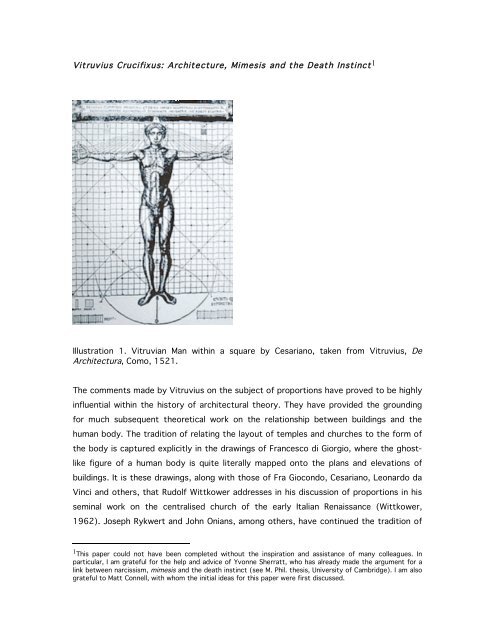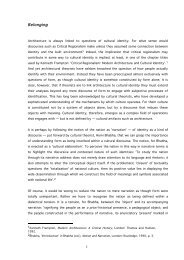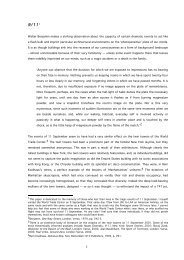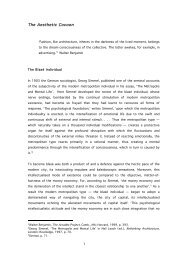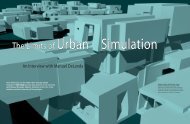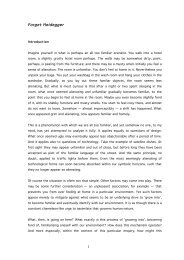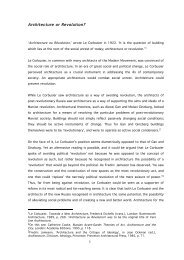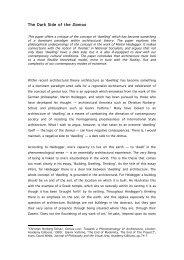Vitruvius Crucifixus: Architecture, Mimesis and the ... - Neil Leach
Vitruvius Crucifixus: Architecture, Mimesis and the ... - Neil Leach
Vitruvius Crucifixus: Architecture, Mimesis and the ... - Neil Leach
You also want an ePaper? Increase the reach of your titles
YUMPU automatically turns print PDFs into web optimized ePapers that Google loves.
1<strong>Vitruvius</strong> <strong>Crucifixus</strong>: <strong>Architecture</strong>, <strong>Mimesis</strong> <strong>and</strong> <strong>the</strong> Death Instinct 1Illustration 1. Vitruvian Man within a square by Cesariano, taken from <strong>Vitruvius</strong>, DeArchitectura, Como, 1521.The comments made by <strong>Vitruvius</strong> on <strong>the</strong> subject of proportions have proved to be highlyinfluential within <strong>the</strong> history of architectural <strong>the</strong>ory. They have provided <strong>the</strong> groundingfor much subsequent <strong>the</strong>oretical work on <strong>the</strong> relationship between buildings <strong>and</strong> <strong>the</strong>human body. The tradition of relating <strong>the</strong> layout of temples <strong>and</strong> churches to <strong>the</strong> form of<strong>the</strong> body is captured explicitly in <strong>the</strong> drawings of Francesco di Giorgio, where <strong>the</strong> ghostlikefigure of a human body is quite literally mapped onto <strong>the</strong> plans <strong>and</strong> elevations ofbuildings. It is <strong>the</strong>se drawings, along with those of Fra Giocondo, Cesariano, Leonardo daVinci <strong>and</strong> o<strong>the</strong>rs, that Rudolf Wittkower addresses in his discussion of proportions in hisseminal work on <strong>the</strong> centralised church of <strong>the</strong> early Italian Renaissance (Wittkower,1962). Joseph Rykwert <strong>and</strong> John Onians, among o<strong>the</strong>rs, have continued <strong>the</strong> tradition of1 This paper could not have been completed without <strong>the</strong> inspiration <strong>and</strong> assistance of many colleagues. Inparticular, I am grateful for <strong>the</strong> help <strong>and</strong> advice of Yvonne Sherratt, who has already made <strong>the</strong> argument for alink between narcissism, mimesis <strong>and</strong> <strong>the</strong> death instinct (see M. Phil. <strong>the</strong>sis, University of Cambridge). I am alsograteful to Matt Connell, with whom <strong>the</strong> initial ideas for this paper were first discussed.
2scholarship emanating from Wittkower’s earlier insights on <strong>the</strong> links between <strong>the</strong> humanbody <strong>and</strong> buildings. It could be argued, however, that <strong>the</strong> full significance of <strong>Vitruvius</strong>’scomments has yet to be understood. The concern of <strong>the</strong>se scholars has been largely for<strong>the</strong> symbolic meaning of <strong>the</strong>se proportions <strong>and</strong> <strong>the</strong> ma<strong>the</strong>matical ratios that underpin<strong>the</strong>m. So far <strong>the</strong>re has been little investigation into <strong>the</strong> question of how <strong>the</strong> use of <strong>the</strong>seproportions might help human beings to relate to buildings at a psychical level.Traditionally, proportions have often been viewed as something ‘out <strong>the</strong>re’. It is perhapsonly for God to recognise <strong>the</strong>m. If we are to pursue an existing model of how we mightidentify with those proportions, at best we might perhaps follow <strong>the</strong> logic of <strong>the</strong>Phaedrus, where Plato argues that when we sense something ‘harmonic’ our soulsrecognise <strong>the</strong> fundamental order of <strong>the</strong> universe. (Plato, 1973: 50-57) According toPlato, souls are mixed in <strong>the</strong> chora of <strong>the</strong> universe of <strong>the</strong> same substance as <strong>the</strong> universeitself. The tension that exists between <strong>the</strong> imperfect mortal body <strong>and</strong> <strong>the</strong> perfectimmortal soul composed as it is of <strong>the</strong> stuff of <strong>the</strong> universe, is set right by recognition of<strong>the</strong> essential harmony of <strong>the</strong> universe, revealed in an harmonious sound or image. It isthis Platonic tradition which informs more recent ontological enquiries, notably <strong>the</strong> workof Hans-Georg Gadamer in The Relevance of <strong>the</strong> Beautiful. (Gadamer, 1986.)Questions about <strong>the</strong> body, however, <strong>and</strong> about <strong>the</strong> way in which human beings identifywith <strong>the</strong> world have been central to much recent <strong>the</strong>oretical debate, not least in <strong>the</strong>domain of psychoanalysis. And it is to psychoanalytic <strong>the</strong>ory that we might turn in orderto shed some fresh light on <strong>the</strong>se issues, <strong>and</strong> to fur<strong>the</strong>r our underst<strong>and</strong>ing as to how <strong>the</strong>use of proportions might offer a mechanism to enhance <strong>the</strong> way in which human beingsrelate to <strong>the</strong>ir built environment at a psychical level.<strong>Vitruvius</strong> <strong>Crucifixus</strong>We might start, perhaps, with one of <strong>the</strong> most famous illustrations on <strong>the</strong> <strong>the</strong>me ofproportions, that of Vitruvian man to be found in Cesariano’s 1521 edition of <strong>Vitruvius</strong>,De Architectura. [Illustration 1] This is one of two images with which Cesarianoillustrates <strong>Vitruvius</strong>’s comments on <strong>the</strong> human body, which is so perfectly proportioned,that it may be inscribed within ei<strong>the</strong>r a circle or a square.
3‘For if a man be placed flat on his back, with his h<strong>and</strong>s <strong>and</strong> feet extended, <strong>and</strong> apair of compasses centred at his navel, <strong>the</strong> fingers <strong>and</strong> toes of his two h<strong>and</strong>s <strong>and</strong>feet will touch <strong>the</strong> circumference of a circle described <strong>the</strong>refrom. And just as <strong>the</strong>human body yields a circular outline, so too a square figure may be found from it.For if we measure <strong>the</strong> distance from <strong>the</strong> soles of <strong>the</strong> feet to <strong>the</strong> top of <strong>the</strong> head,<strong>and</strong> <strong>the</strong>n apply that measure to <strong>the</strong> outstretched arms, <strong>the</strong> breadth will be foundto be <strong>the</strong> same as <strong>the</strong> height.’ (<strong>Vitruvius</strong>, 1960: 73.)One of <strong>the</strong> intriguing aspects of this illustration is <strong>the</strong> similarity which <strong>the</strong> figure bears toimages of <strong>the</strong> crucified Christ. There are a number of incidental parallels between <strong>the</strong>two persons, <strong>and</strong> a clear stylistic indebtedness to <strong>the</strong> crucified Christ in representationsof Vitruvian man. In some, for example, Vitruvian man is seen to have his head slumpedto one side. But in this one by Cesariano, not only is <strong>the</strong>re a scroll above <strong>the</strong> head of <strong>the</strong>figure reminiscent of <strong>the</strong> INRI of <strong>the</strong> crucifix, but <strong>the</strong> h<strong>and</strong>s <strong>and</strong> feet are displayedprecisely as though <strong>the</strong>y have been affixed to <strong>the</strong> cross. The parallels extend toCesariano’s o<strong>the</strong>r famous image of Vitruvian man. Alongside <strong>the</strong> image of Vitruvian maninscribed within <strong>the</strong> square, Cesariano includes a second image of Vitruvian man, a manspread-eagled within a circle, his h<strong>and</strong>s <strong>and</strong> feet touching <strong>the</strong> circumference of thatcircle. [Ill. 3] As <strong>Vitruvius</strong> describes in <strong>the</strong> original text, here <strong>the</strong> man is ‘stabbed’ in hismidrift by one arm of a pair of compasses, while <strong>the</strong> o<strong>the</strong>r arm is used to circumscribe<strong>the</strong> figure, ‘striking’ <strong>the</strong> h<strong>and</strong>s <strong>and</strong> <strong>the</strong> feet. Vitruvian man is thus ‘wounded’ in <strong>the</strong> sameparts as Christ. But it is <strong>the</strong> first image — Vitruvian man inscribed within a square —which is more immediately reminiscent of images of <strong>the</strong> crucifix.The links between Christ <strong>and</strong> <strong>Vitruvius</strong> have been observed by a number of scholars. Thetwo, it has been noted, were near contemporaries. 2 Fur<strong>the</strong>rmore, <strong>Vitruvius</strong>’s commentson <strong>the</strong> ideal proportions of <strong>the</strong> human figure, which should also be present in <strong>the</strong> layoutof temples has, of course, exerted a major influence on <strong>the</strong> design of christian churchesthroughout <strong>the</strong> Renaissance. Not only do we find proportions of idealised human figuresinscribed in various plans of christian buildings, but representations of Christ himself takeon <strong>the</strong> proportions of Vitruvian man. As has been observed, Brunelleschi’s woodencrucifix in <strong>the</strong> church of Santa Maria Novella in Florence shows Christ with <strong>the</strong>proportions of <strong>the</strong> homo ad quadratum, <strong>the</strong> distance between his outstretched h<strong>and</strong>smatching his height from head to toe. 3 Nor is it out of place that Brunelleschi should2 See, for example, <strong>the</strong> comments of John Dee in Hart, V. 1994:. 69-71.3 On this see Battisti, E: 42. For a detailed elaboration of this subject, see Casazza <strong>and</strong> Boddi,: 207-212.
4have chosen to portray Christ, <strong>the</strong> very manifestation of God on earth, with <strong>the</strong> ‘perfect’proportions of Vitruvian man, proportions which echo <strong>the</strong> cosmic harmony of <strong>the</strong>universe. With Brunelleschi’s crucifix, Christ has become ‘Vitruvianised’. Yet <strong>the</strong>Renaissance was as much about <strong>the</strong> christianisation of a Vitruvian tradition as it wasabout <strong>the</strong> Vitruvianisation of a christian one. Hence we find in Cesariano’s illustrations aclear allusion to <strong>the</strong> crucified Christ, which fur<strong>the</strong>r develops <strong>the</strong> links betweenarchitectural form <strong>and</strong> <strong>the</strong> crucifixion of Christ, already evident in <strong>the</strong> cruciform layout of<strong>the</strong> medieval basilica.Illustration 2: Crucifix, Filippo Brunelleschi, Santa Maria Novella, FlorenceThis connection — this christianisation of Vitruvian man — is fur<strong>the</strong>r corroborated by <strong>the</strong>manuscripts of <strong>Vitruvius</strong>. There are two variants in <strong>the</strong> text that describes <strong>the</strong> way inwhich <strong>the</strong> h<strong>and</strong>s are held out in <strong>the</strong> figure of Vitruvian man. The manuscripts here varybetween <strong>the</strong> use of <strong>the</strong> (more common) form ‘manus pansas’ <strong>and</strong> <strong>the</strong> variant ‘manusspansas’. (<strong>Vitruvius</strong>, 1990: 7) The verb ‘p<strong>and</strong>ere’ simply means ‘to open out’, or ‘toextend’. The h<strong>and</strong>s are ‘outstretched’. In <strong>the</strong> variant <strong>the</strong> verb ‘sp<strong>and</strong>ere’ is used. Thishas a secondary meaning of <strong>the</strong> way that a priest holds out his h<strong>and</strong>s ‘in prayer’. 4 Thevariant ‘manus spansas’ <strong>the</strong>refore marks a religious moment in <strong>the</strong> representation of4 Sp<strong>and</strong>ere is a contraction of exp<strong>and</strong>ere. See s.v., Thesaurus Linguae Latinae, Leipzig: Teubner, 1931, vol. 5,p. 1599: ‘porrigere; de Christianis qui orantes bracchia in crucis formam extendunt’, (Cf. Tert. Orat. 29, p. 200.9; Paul. Med., Vita Ambr., 47)
5Vitruvian man. From Vitruvian man with his h<strong>and</strong>s ‘outstretched’ we move to Vitruvianman with his h<strong>and</strong>s ‘outstretched in prayer’. It is in this shift from ‘manus pansas’ to‘manus spansas’, from <strong>the</strong> h<strong>and</strong>s ‘outstretched’ to <strong>the</strong> h<strong>and</strong>s ‘outstretched in prayer’that Vitruvian man becomes, in effect, ‘christianised’. It is in this shift that we recognisenot only <strong>the</strong> Vitruvianisation of <strong>the</strong> Christian world, but also its corollary, <strong>the</strong>Christianisation of <strong>the</strong> Vitruvian world. In effect, Vitruvian man adopts <strong>the</strong> posture ofChrist on <strong>the</strong> cross. Vitruvian man becomes crucified. <strong>Vitruvius</strong> crucifixus.Freud <strong>and</strong> <strong>the</strong> ‘Death Instinct’How, <strong>the</strong>n, might psychoanalytic <strong>the</strong>ory help us to underst<strong>and</strong> <strong>the</strong> role of proportions? Itis through <strong>the</strong> emblem of Vitruvian man on <strong>the</strong> cross — <strong>the</strong>, as it were, dying, crucifiedVitruvian man — that we might approach <strong>the</strong> <strong>the</strong>me of ‘death’, <strong>and</strong> through this engagewith one of <strong>the</strong> central <strong>the</strong>mes in psychoanalysis. And it is through a creative <strong>and</strong>deliberately indulgent reworking of Freud’s work on ‘death’ that we might begin tounderst<strong>and</strong> <strong>the</strong> role of proportions in helping <strong>the</strong> individual to identify with <strong>the</strong> builtenvironment.The <strong>the</strong>me of ‘death’ is, of course, fundamental to Freud, especially to <strong>the</strong> late Freud,<strong>the</strong> metapsychological Freud. Freud’s late <strong>the</strong>ory is centred around <strong>the</strong> conflict betweenEros <strong>and</strong> Thanatos, between ‘love’ <strong>and</strong> ‘death’, between ‘life instincts’ <strong>and</strong> ‘deathinstincts’. Eros, as <strong>the</strong> ‘life instinct’, serves to counter <strong>the</strong> tendency towards Thanatos,<strong>the</strong> ‘death instinct’, <strong>and</strong> acts as a force to complicate life. It continuously counteracts<strong>and</strong> delays <strong>the</strong> ‘death instinct’. Eros is <strong>the</strong>refore set in opposition to Thanatos, thatwhich seeks resolution <strong>and</strong> quiet. Thus <strong>the</strong> ‘death drive’ becomes for Freud one of <strong>the</strong>fundamental impulses within human behaviour.The ‘death drive’ in Freud can be seen to emanate from <strong>the</strong> moment of birth itself. Birthis seen as a violent trauma which upsets <strong>the</strong> pleasure of <strong>the</strong> time in <strong>the</strong> womb. For Freud<strong>the</strong> time in <strong>the</strong> womb relates to <strong>the</strong> development of <strong>the</strong> ‘id’, <strong>the</strong> ‘id’ being <strong>the</strong> facultythat absorbs <strong>and</strong> enjoys pleasurable sensations. The ‘id’ is <strong>the</strong> domain of <strong>the</strong>unconscious. Herbert Marcuse defines <strong>the</strong> ‘id’ as follows:The ‘id’ is free from <strong>the</strong> forms <strong>and</strong> principles which constitute <strong>the</strong> conscious,social individual. It is nei<strong>the</strong>r affected by time nor troubled by contradictions:
6it knows “no values, no good <strong>and</strong> evil, no morality”. It does not aim at selfpreservation:all it strives for is satisfaction of its instinctual needs, inaccordance with <strong>the</strong> pleasure principle. (Marcuse, 1969: 29-30)The womb provides <strong>the</strong> ‘id’ with a refuge, a state of placid protection <strong>and</strong> constantgratification. With birth this freedom from disturbance is lost forever. Yet <strong>the</strong> memory ofthis period in <strong>the</strong> womb remains, <strong>and</strong> subsequent life is governed by a desire to regainthis lost quietude, this lost paradise. Life is dominated by a regressive compulsion, adesire to return to <strong>the</strong> womb. This striving for ‘integral gratification’ dominates allsubsequent life. Thus for Freud <strong>the</strong> drive towards equilibrium that results is none o<strong>the</strong>rthan a ‘continuous descent toward death’, where death finally provides that longed forresolution <strong>and</strong> quiet. According to Marcuse:The death instinct is destructiveness not for its own sake, but for <strong>the</strong> relief oftension. The descent toward death is an unconscious flight from pain <strong>and</strong>want. It is an eternal struggle against suffering <strong>and</strong> repression. (Marcuse,1969: 29)From this drive towards equilibrium Freud develops <strong>the</strong> ‘Nirvana principle’ — <strong>the</strong> urge toreturn to <strong>the</strong> Nirvana of <strong>the</strong> womb — which becomes for Freud ‘<strong>the</strong> dominating tendencyof mental life, <strong>and</strong> perhaps nervous life in general’.Related to <strong>the</strong> ‘Nirvana Principle’ is <strong>the</strong> ‘pleasure principle’, which is, in effect, oneexpression of <strong>the</strong> ‘Nirvana Principle’:. . .<strong>the</strong> effort to reduce, to keep constant or to remove internal tension dueto stimuli (<strong>the</strong> ‘Nirvana principle’. . .) finds expression in <strong>the</strong> pleasureprinciple; <strong>and</strong> our recognition of this fact is one of <strong>the</strong> strongest reasons forbelieving in <strong>the</strong> existence of death instincts.’ (Freud, 1984: 329)At a straightforward level, <strong>the</strong>n, we might recognise an apparent parallel between <strong>the</strong>‘drive’ for harmony within <strong>the</strong> principle of architectural proportions, as recognised by<strong>Vitruvius</strong>, <strong>and</strong> <strong>the</strong> ‘drive’ for resolution that underpins <strong>the</strong> ‘death instinct’ in Freud. Thereis an obvious point of comparison between <strong>the</strong> state of equilibrium sought inproportions, <strong>and</strong> <strong>the</strong> equilibrium of <strong>the</strong> ‘Nirvana principle’. The harmony sought in <strong>the</strong>proportions of Vitruvian man — <strong>the</strong>, as it were, ‘dying’, crucified, Vitruvian man —
7matches <strong>the</strong> harmony sought in <strong>the</strong> ‘death instinct’ in Freud. Proportions offer amechanism that strives for a resolution, a reconciliation of tensions. The aes<strong>the</strong>ticgratification of harmonic proportions in architecture might <strong>the</strong>refore be seen torepresent a return to <strong>the</strong> Nirvana of <strong>the</strong> womb, to <strong>the</strong> sensory realm of <strong>the</strong> protected.Yet this realm need not be a closed, interior space. It need not be a ‘womb-like’ space.Indeed, according to <strong>the</strong> logic of <strong>the</strong> argument, ‘open’ architecture would have a similareffect, providing that it is harmonious.By itself, however, this model appears to be somewhat inadequate. It cannot account for<strong>the</strong> stimulation that may be induced by this release of tensions. Harmonious architecturemay equally prove to be innervating. It is as though <strong>the</strong> gratification of aes<strong>the</strong>ticcontemplation might serve not so much to resolve <strong>the</strong> death instinct as to transcend it.Marcuse <strong>and</strong> NarcissusIllustration 3. Caravaggio, Narcissus (Rome, Galleria Nazionale d’Arte Antica)
8Here we might refer to <strong>the</strong> work of Herbert Marcuse, a somewhat unlikely figure in thiscontext, in that his work has been concerned largely with <strong>the</strong> <strong>the</strong>me of Eros ra<strong>the</strong>r thanThanatos. Yet he offers a fur<strong>the</strong>r interpretation of <strong>the</strong> interplay of Eros <strong>and</strong> Thanatos in<strong>the</strong> moment of aes<strong>the</strong>tic contemplation which sheds some light on this question.According to Marcuse, <strong>the</strong> distinction between Eros <strong>and</strong> Thanatos is not fully resolved inFreud. Marcuse goes on to suggest that <strong>the</strong>se two seemingly opposite drives have acommon origin, <strong>and</strong> may <strong>the</strong>refore be reconciled. For Marcuse <strong>the</strong> crucial images thatbring toge<strong>the</strong>r Eros <strong>and</strong> Thanatos are Orpheus <strong>and</strong> Narcissus. Orpheus is <strong>the</strong> poet whoplays so beautifully on his lyre that he is able to hold even wild animals spellbound.Narcissus, meanwhile, is <strong>the</strong> beautiful youth whom Aphrodite punishes for spurning <strong>the</strong>advances of Echo by making him obsessed with his own image. [ill. 2] His frustratedattempts to grasp his own image reflected in a pool lead to his despair <strong>and</strong> death. On hisdeath Narcissus’s body turns into a flower of <strong>the</strong> same name.Marcuse picks up on <strong>the</strong> models of Narcissus <strong>and</strong> Orpheus. For Marcuse, <strong>the</strong> images ofOrpheus <strong>and</strong> Narcissus reconcile Eros <strong>and</strong> Thanatos:They recall <strong>the</strong> experience of a world that is not to be mastered <strong>and</strong>controlled but to be liberated — a freedom that will release <strong>the</strong> powers ofEros now bound to <strong>the</strong> petrified forms of man <strong>and</strong> nature. These powers areconceived not as destruction but as peace, not as terror but as beauty. It issufficient to enumerate <strong>the</strong> assembled images in order to circumscribe <strong>the</strong>dimension to which <strong>the</strong>y are committed: <strong>the</strong> redemption of pleasure, <strong>the</strong> haltof time, <strong>the</strong> absorption of death; silence, sleep, night, paradise — <strong>the</strong> Nirvanaprinciple not as death but as life. (Marcuse, 1969: 164)In this fusion of <strong>the</strong> Orphic <strong>and</strong> <strong>the</strong> Narcissistic world Marcuse sees a reconciliation ofEros <strong>and</strong> Thanatos. In this sense he goes beyond Freud to offer a vision in which artplays a creative role. It is a world which embodies <strong>the</strong> principles of both Eros <strong>and</strong>Thanatos, a static world, a world at rest, but a fundamentally poetic world. It is a worldwhere ‘static triumphs over dynamic; but it is a static that moves in its own fullness — aproductivity that is sensuousness, play <strong>and</strong> song.’ (Marcuse, 1969: 164)The Nirvana principle — <strong>the</strong> return to <strong>the</strong> womb — gives us a sense of <strong>the</strong> real meaningof ‘death’ in <strong>the</strong> ‘death instinct’. Death is not death as finality, as absence of life. Thedeath instinct calls for a death which is not death, a death which transcends death, a
9death which is put in <strong>the</strong> service of life. This death is akin to <strong>the</strong> death of Christ on <strong>the</strong>cross — to return to our starting point — a death that gives o<strong>the</strong>rs life. Likewise, it isakin to <strong>the</strong> death of Narcissus — <strong>the</strong> ecstacy of <strong>the</strong> narcissistic absorption into <strong>the</strong> self— a death that results in <strong>the</strong> birth of a flower. It is in <strong>the</strong> resurrection from <strong>the</strong> cross, in<strong>the</strong> blossoming of <strong>the</strong> flower, that <strong>the</strong> ‘death instinct’ is realised <strong>and</strong> death itself istranscended.The myth of Narcissus also gives us an insight into <strong>the</strong> way in which we interact with ourenvironment. Unlike Orpheus who worked with song, Narcissus was obsessed withcontemplation <strong>and</strong> aes<strong>the</strong>tic beauty, <strong>and</strong> as such relates more to <strong>the</strong> realm ofarchitecture. Marcuse’s model of Narcissus comes from <strong>the</strong> world of myth <strong>and</strong> painting.We should also consider, however, <strong>the</strong> motif of Narcissus as it was pursued by Freud.In Freud Narcissus becomes one of <strong>the</strong> two models of object-love: ‘anaclitic’ <strong>and</strong>‘narcissistic’. According to Freud <strong>the</strong>re is a primary narcissism in everyone. Thisnarcissistic love can take four forms. To quote Freud, a person may love:1. What he himself is.2. What he himself was.3. What he himself would like to be.4. Someone who was once part of himself. (Freud, 1984: 84)Freud sees narcissism as a negative mechanism. He sees it as a regressive, childishdelusion, that in effect prevents us from recognising <strong>the</strong> ‘o<strong>the</strong>r’ in <strong>the</strong> ‘o<strong>the</strong>r’.Narcissism, for Freud, would mean that we constantly see ourselves in <strong>the</strong> ‘o<strong>the</strong>r’, <strong>and</strong>cannot fully grasp <strong>the</strong> alterity of <strong>the</strong> ‘o<strong>the</strong>r’. Anaclitic love, by comparison, is preferable,because it respects ‘o<strong>the</strong>rness’. Here, however, I want to read Freud against Freud, <strong>and</strong>suggest an alternative approach to narcissism. I would want to suggest — in line with anumber of more recent <strong>the</strong>orists — that <strong>the</strong>re is something positive in narcissism thatneeds to be rescued.Narcissism in Freud refers to a mechanism for potential engagement with <strong>the</strong> ‘o<strong>the</strong>r’,even though <strong>the</strong> ‘o<strong>the</strong>r’ may in fact be <strong>the</strong> ‘self’. Subjects ‘read <strong>the</strong>mselves’ into <strong>the</strong>‘o<strong>the</strong>r’, see <strong>the</strong>mselves reflected in <strong>the</strong> ‘o<strong>the</strong>r’. In effect <strong>the</strong> figure of Narcissus isemblematic of a mode of engaging with — identifying with — <strong>the</strong> o<strong>the</strong>r. It becomes, ino<strong>the</strong>r words, a means by which <strong>the</strong> subject can identify with <strong>the</strong> object. Narcissus st<strong>and</strong>s
12unconscious <strong>and</strong> <strong>the</strong> conscious, dream <strong>and</strong> reality. Here fantasy is used as a positiveterm. Fantasy creates its own fictions not as a way of escaping reality, but as a way ofaccessing reality, a reality that is ontologically charged, <strong>and</strong> not constrained by aninstrumentalised view of <strong>the</strong> world. In effect mimesis is an unconscious identificationwith <strong>the</strong> object. It necessarily involves a creative moment on <strong>the</strong> part of <strong>the</strong> subject.The subject creatively identifies with <strong>the</strong> object, so that <strong>the</strong> object, even if it is atechnical object — a piece of machinery, a car, a plane, a bridge, whatever — becomesinvested with some symbolic significance, <strong>and</strong> is appropriated as part of <strong>the</strong> symbolicbackground through which individuals constitute <strong>the</strong>ir identity.It is important to recognise here <strong>the</strong> question of temporality. Symbolic significance mayshift — often dramatically — over a period of time. What was once shockingly alien mayeventually appear reassuringly familiar. The way in which we engage with architecturemust <strong>the</strong>refore be seen not as a static condition, but as a dynamic process. The logic ofmimesis dictates that we are constantly assimilating to <strong>the</strong> built environment, <strong>and</strong> that,consequently, our attitudes towards it are for ever changing. The very process ofassimilation within mimesis, as it is used here, implies an appropriation, a ‘claiming’ of <strong>the</strong>object, <strong>and</strong> it is here, perhaps, that parallels with hermeneutics are most obvious. 7 Theunderst<strong>and</strong>ing of mimesis as a form of creative appropriation echoes <strong>the</strong> <strong>the</strong>me ofNarcissus trying to reach out <strong>and</strong> appropriate his own image. Benjamin evokes this<strong>the</strong>me in his description of <strong>the</strong> mimetic impulse: ‘Every day <strong>the</strong> urge grows stronger toget hold of an object at very close range by way of its likeness, its reproduction.’(Benjamin, 1969: 217) The assimilation which mimesis dem<strong>and</strong>s with <strong>the</strong> inanimateworld reveals <strong>the</strong> link with <strong>the</strong> death instinct. The action of mimesis constitutes analmost chameleon-like process of adaptation. This process, as Miriam Hansen observes,‘involves <strong>the</strong> slippage between life <strong>and</strong> death, <strong>the</strong> assimilation of lifeless material . . orfeigning death for <strong>the</strong> sake of survival.’ (Hansen, 1993: 53)The origin of this process lies in <strong>the</strong> instinctual mechanisms of self-preservation. Animals,when trapped in potentially life-threatening situations, ra<strong>the</strong>r than run away, will oftenfreeze into seemingly lifeless forms. Through this action <strong>the</strong>y attempt to blend with <strong>the</strong>irenvironment, <strong>and</strong> <strong>the</strong>reby escape <strong>the</strong> gaze of <strong>the</strong> predator. A similar trait may be foundin humans. ‘The reflexes of stiffening <strong>and</strong> numbness,’ as Adorno <strong>and</strong> Horkheimer note,7 On this see Jacques Derrrida’s critique of hermeneutics in Derrida, 1987: 255 ff. Likewise mimesis can beseen to share <strong>the</strong> same epistemological fragility of hermeneutics, in that its only source of validation is that of<strong>the</strong> interpreting agent.
13‘are archaic schemata of <strong>the</strong> urge to survive, by adaptation to death life pays <strong>the</strong> toll ofits continued existence.’ (Adorno <strong>and</strong> Horkheimer, 1979: 180) Thus, somewhatparadoxically, <strong>the</strong> feigning of death preserves life. ‘Death’ is used in <strong>the</strong> service of life.This is a tactic that represents not simply <strong>the</strong> subordination of <strong>the</strong> self to nature, butalso an overcoming of nature, a defence against <strong>the</strong> dissolution of <strong>the</strong> self. Benjaminhimself distinguishes between a mimesis of pure sublimation of <strong>the</strong> self, which seeks toblend in with <strong>the</strong> environment purely defensively, <strong>and</strong> a mimesis of ‘innervation’ whichsees <strong>the</strong> environment as a source of empowerment. A mimesis of ‘innervation’ stresses<strong>the</strong> creative act of self expression against a given background. And it is precisely thisactive — ra<strong>the</strong>r than defensive — form of mimesis which offers a basis for creativeexpression in art.<strong>Mimesis</strong> <strong>the</strong>refore constitutes a form of mimicry, — but it is an adaptive mimicry — justas when a child learns to speak <strong>and</strong> adapt to <strong>the</strong> world, or when owners take on <strong>the</strong>characteristics of <strong>the</strong>ir pets. In fact it is precisely <strong>the</strong> example of <strong>the</strong> child ‘growing into’language that best illustrates <strong>the</strong> operation of mimesis. The child ‘absorbs’ an externallanguage by a process of imitation <strong>and</strong> <strong>the</strong>n uses it creatively for its own purposes.Similarly, within <strong>the</strong> realm of architecture we might see mimesis at work as architectsdevelop <strong>the</strong>ir design abilities: it is this process which also allows external forms to beabsorbed <strong>and</strong> sedimented as part of a language of design. Clearly, mimesis goes beyondstraightforward mimicry, if by mimicry we underst<strong>and</strong> a response which is merelyinstinctual. <strong>Mimesis</strong> necessarily involves a sense of volition <strong>and</strong> intentionality on <strong>the</strong> partof <strong>the</strong> subject. It does not simply look back <strong>and</strong> mimic what is already given, but it relieson a process of creative engagement, of ‘conjuring up’ something for <strong>the</strong> future. It is inthis moment that <strong>the</strong> magical base of mimesis manifests itself. Like <strong>the</strong> magician whoplans <strong>the</strong> trick, mimesis contains within it <strong>the</strong> sense of control of some organisedproject. Yet what distiniguishes mimesis from magic is that it does not attempt todeceive in <strong>the</strong> same way. Thus, for Adorno, art as a form of mimesis is ‘magic deliveredfrom <strong>the</strong> lie of being truth.’ (Adorno, ???: 222) In distancing itself from <strong>the</strong> illusionisticclaims of magic, mimesis surpasses magic, while none<strong>the</strong>less remaining within itsconceptual orbit.Although mimesis involves a degree of organised control, <strong>and</strong> <strong>the</strong>refore operates inconjunction with rationality, this does not mean that mimesis is part of rationality.Indeed, in terms of <strong>the</strong> dialectic of <strong>the</strong> enlightenment, we might perceive mimesis asconstitutive not of rationality, but of myth, its magical ‘o<strong>the</strong>r’. <strong>Mimesis</strong> <strong>and</strong> rationality,
14as Adorno observes, are ‘irreconcilable’. (Adorno, 1984: 81) If mimesis is to beperceived as a form of correspondence with <strong>the</strong> outside world which is articulated within<strong>the</strong> aura of <strong>the</strong> work of art, <strong>the</strong>n enlightenment rationality, with its effective splitbetween subject <strong>and</strong> object, <strong>and</strong> increasing emphasis on knowledge-as-quantificationover knowledge-as-sensuous-correspondence, represents <strong>the</strong> opposite pole. In <strong>the</strong>instrumentalised view of <strong>the</strong> enlightenment, knowledge is ordered <strong>and</strong> categorised,valorised according to scientific principles, <strong>and</strong> <strong>the</strong> rich potential of mimesis isoverlooked. All this entails a loss, a reduction of <strong>the</strong> world to a reified structure ofsubject/object divides, as mimesis retreats even fur<strong>the</strong>r into <strong>the</strong> mythic realm ofliterature <strong>and</strong> <strong>the</strong> arts.At <strong>the</strong> same time mimesis might provide a dialectical foil to <strong>the</strong> subject/object split ofenlightenment rationality. This is most obvious in <strong>the</strong> case of language. Languagebecomes <strong>the</strong> ‘highest level of mimetic behaviour, <strong>the</strong> most complete archive of nonsensuoussimilarity’. 8 (Benjamin, 1978: 336) <strong>Mimesis</strong> for Benjamin offers a way offinding meaning in <strong>the</strong> world, through <strong>the</strong> discovery of similarities. These similaritiesbecome absorbed <strong>and</strong> <strong>the</strong>n rearticulated in language, no less than in dance or o<strong>the</strong>r artforms. As such language becomes a repository of meaning, <strong>and</strong> writing becomes anactivity which extends beyond itself, so that in <strong>the</strong> process of writing writers engage inunconscious processes of which <strong>the</strong>y may not be aware. Indeed writing often revealsmore than <strong>the</strong> writer is conscious of revealing. Likewise <strong>the</strong> reader must decode <strong>the</strong>words resorting to <strong>the</strong> realm of <strong>the</strong> imagination which exceeds <strong>the</strong> purely rational. Thus<strong>the</strong> activity of reading also embodies <strong>the</strong> principles of mimesis, serving as <strong>the</strong> vehicle forsome revelatory moment. For Benjamin <strong>the</strong> meaning becomes apparent in a constellatoryflash, a dialectics of seeing, in which subject <strong>and</strong> object become one for a brief moment,a process which relates to <strong>the</strong> experience of architecture no less than <strong>the</strong> reading oftexts.<strong>Vitruvius</strong> <strong>Crucifixus</strong><strong>Architecture</strong>, <strong>the</strong>refore, along with <strong>the</strong> o<strong>the</strong>r visual arts can be viewed as a potentialreservoir for <strong>the</strong> operation of mimesis. In <strong>the</strong> design of buildings <strong>the</strong> architect mayarticulate <strong>the</strong> relational correspondence with <strong>the</strong> world that is embodied in <strong>the</strong> concept8 For Adorno mimesis refers to a sensuous correspondence with <strong>the</strong> world. On this see footnote 5 above.
15of mimesis. These forms may be interpreted in a similar fashion by those who experience<strong>the</strong> building, in that <strong>the</strong> mechanism by which human beings begin to feel at home in <strong>the</strong>built environment can also be seen as a mimetic one.<strong>Mimesis</strong>, <strong>the</strong>n, may help to explain how we identify progressively with our surroundings.In effect, we read ourselves into our surroundings, without being fully conscious of it. ‘Bymeans of <strong>the</strong> mimetic impulse,’ as Adorno comments, ‘<strong>the</strong> living being equates himselfwith objects in his surroundings’. Understood in <strong>the</strong> terms of our discussion of Narcissus,this mimetic impulse might be seen as a mechanism for reading ourselves into <strong>the</strong> o<strong>the</strong>r.We relate ourselves to our environment by a process of narcissistic identification, <strong>and</strong>mimetically absorb <strong>the</strong> language of that environment. Just as Narcissus saw his ownimage in <strong>the</strong> water, without recognising it as his own image, so we identify ourselveswith <strong>the</strong> ‘o<strong>the</strong>r’ — symbolically — without realising that recognition of <strong>the</strong> ‘o<strong>the</strong>r’ mustbe understood in terms of a mimetic identification with <strong>the</strong> o<strong>the</strong>r, as a reflection of <strong>the</strong>self. And this refers not to a literal reflection of our image, so much as <strong>the</strong> metaphoricalreflection of our symbolic outlook <strong>and</strong> values.The aim throughout is to forge a creative relationship with our environment. When wesee our values ‘reflected’ in our surroundings, this feeds our narcissistic urge, <strong>and</strong> breaksdown <strong>the</strong> subject/object divide. It is as though — to use Walter Benjamin’s use of <strong>the</strong>term mimesis — in <strong>the</strong> flash of <strong>the</strong> mimetic moment, <strong>the</strong> fragmentary is recognised aspart of <strong>the</strong> whole, <strong>and</strong> <strong>the</strong> individual is inserted within an harmonic totality.It is within this framework that we can begin to address <strong>the</strong> role of proportions, whichcan be understood as emblematic of an attempt to relate to <strong>the</strong> built environment, notthrough empathy, but through identification. The use of <strong>the</strong> human figure — <strong>and</strong> <strong>the</strong> useof human proportions, albeit of an idealised human figure — represents an enablingmechanism, by which this process might be enhanced. The human figure is ‘reflected’back out of <strong>the</strong> object. The human figure is ‘echoed’ — to use a term from <strong>the</strong> myth ofNarcissus — in <strong>the</strong> building. Yet, here equally <strong>the</strong> limitations of proportions are exposed.If proportions are to achieve <strong>the</strong>ir objective <strong>the</strong>y must offer a framework for a creativeengagement with <strong>the</strong> world. The subject must be able to ab<strong>and</strong>on itself in assimilationwith <strong>the</strong> non-identical. Once proportions become codified into an instrumentalisedsystem, however, <strong>the</strong>y enter into a terroristic st<strong>and</strong>ard of totalitarian rule, a logic ofdomination. Human values are imposed upon <strong>the</strong> environment, ra<strong>the</strong>r than humankind
16subjecting <strong>the</strong>mselves to <strong>the</strong> environment, assimilating to it in a process of mimeticidentification. It is a case of natura naturata versus natura naturans.In this respect, <strong>the</strong> tradition in <strong>the</strong> Renaissance of inscribing human figures into <strong>the</strong> plansof buildings, <strong>and</strong> into <strong>the</strong> elevations of columns <strong>and</strong> so on, can be seen as a form ofmimetic device, which vicariously evokes <strong>the</strong> desire for identification. The figureinscribed within <strong>the</strong> plan becomes a mimetic emblem for a physical body within <strong>the</strong>actual building. The emblem must be understood here as a device which is ‘magically’invested with <strong>the</strong> properties of an originary object, much as in <strong>the</strong> sacrifice when <strong>the</strong>victim is offered up as a substitute for o<strong>the</strong>rs. Thus <strong>the</strong> figure incised in <strong>the</strong> ground plantranscends mere representation. The figure takes on a symbolic significance, which canonly be understood beyond <strong>the</strong> framework of enlightenment rationality. It is preciselythis investment which locates such devices within <strong>the</strong> realm of <strong>the</strong> mythic. Theseemblems become vehicles of identification, <strong>the</strong> objects of wish-fulfillment. This evokes<strong>the</strong> principle of <strong>the</strong> sacrifice, as Lévi-Strauss has described it:For, <strong>the</strong> object of <strong>the</strong> sacrifice precisely is to establish a relation, not ofresemblance, but of contiguity, by means of a series of successiveidentifications. (Lévi-Strauss, 1966: 225)Hence we might read <strong>the</strong>se inscriptions of <strong>the</strong> human body as being informed by amimetic impulse, an attempt to relate to an inanimate object. They act as mimeticdevices, vicarious objects of identification, charged with symbolic significance like <strong>the</strong>victims in a sacrifice.It is here that <strong>the</strong> significance of <strong>the</strong> image of <strong>Vitruvius</strong> <strong>Crucifixus</strong>, Vitruvian man as <strong>the</strong>dying, crucified Christ becomes apparent. The <strong>the</strong>me of sacrifice can also be seen tooperate at a broader level. In our mimetic engagement with <strong>the</strong> built environment it isprecisely <strong>the</strong> ‘self’ which is sacrificed. The subject effectively surrenders <strong>the</strong> self to <strong>the</strong>o<strong>the</strong>r, in order that it might live on through a creative engagement with <strong>the</strong> o<strong>the</strong>r.Narcissus can <strong>the</strong>refore be seen as <strong>the</strong> quintessential emblem for aes<strong>the</strong>ticcontemplation. Gazing at his own reflection, he identifies with <strong>the</strong> image, surrenderinghimself to it. In trying to grasp <strong>the</strong> beauty of that image he drowns, only to give life to aflower. He <strong>the</strong>reby enacts <strong>the</strong> ‘sacrifice’ of mimesis.
17This ‘sacrifice’ — this surrendering to <strong>the</strong> o<strong>the</strong>r — remains a precondition of aes<strong>the</strong>ticexperience. As in <strong>the</strong> myth of Narcissus, <strong>the</strong> sacrifice transcends death. In <strong>the</strong> ‘shock’ ofaes<strong>the</strong>tic recognition, <strong>the</strong> subject is ‘forced open’ <strong>and</strong> exposed to a meaningfulrelationship with <strong>the</strong> object. The subject is decentred <strong>and</strong> broadened. The subjectidentifies with <strong>the</strong> object, <strong>and</strong> it is in <strong>the</strong> forging of new identities during <strong>the</strong> dynamicprocess of mimetic assimilation that death itself is resisted <strong>and</strong> overcome. Hence wemight recognise <strong>the</strong> ‘sacrifice’ that lies at <strong>the</strong> basis of all architecture. As such, myths ofsacrifice, which have filtered into architectural folklore might be understood within <strong>the</strong>framework of mimesis. 9 It is as though <strong>the</strong> sacrifice of a human life is required in orderto ‘animate’ <strong>the</strong> inanimate stone. And we might read this ‘sacrifice’ replicated in <strong>the</strong>sacrifice of <strong>the</strong> self within <strong>the</strong> mimetic identification of aes<strong>the</strong>tic experience.In this process we can recognise an almost ‘mystical’ moment, that shares something ofreligious ecstacy <strong>and</strong> <strong>the</strong> experience of love. If love, in Lacanian terms, is what fills <strong>the</strong>‘gap’ between <strong>the</strong> self <strong>and</strong> o<strong>the</strong>r, mimesis can be seen to be <strong>the</strong> aes<strong>the</strong>tic equivalent oflove. Hence we find terms with clear references to <strong>the</strong> world of love, like jouissance,being used to describe aes<strong>the</strong>tic experiences, while thinkers such as Julia Kristeva havemade explicit comparisons between aes<strong>the</strong>tic experience <strong>and</strong> love. 10 And if <strong>the</strong> ‘death’of Vitruvian man can be seen as a sacrifice that transcends death <strong>and</strong> <strong>the</strong>reby serves <strong>the</strong>life instinct, a sacrifice where thanatos is put at <strong>the</strong> service of eros, <strong>the</strong> erotic characterof this moment is evoked by Cesariano’s o<strong>the</strong>r image of Vitruvian man spread-eagledwithin a circle. [Ill.3]For Benjamin art — through mimesis — takes on a quasi-religious turn, in offering <strong>the</strong>possibility of a return to some lost paradise following <strong>the</strong> ‘fall’ of humankind through <strong>the</strong>instrumentalisation of <strong>the</strong> world. If we are to underst<strong>and</strong> mimesis as offering access tosome form of paradise, <strong>the</strong>n this promise is evoked in <strong>the</strong> mimetic emblem of Vitruvianman. Just as <strong>the</strong> death of Christ on <strong>the</strong> cross opens up <strong>the</strong> possibility of a life afterdeath, just as <strong>the</strong> death of Narcissus gives rise to a flower, so <strong>the</strong> emblematic ‘death’ ofVitruvian man leads to <strong>the</strong> possibility of a deeper, more meaningful engagement with <strong>the</strong>built environment.The aes<strong>the</strong>tic gratification that results from this mimetic moment — <strong>the</strong> recognition of<strong>the</strong> self in <strong>the</strong> o<strong>the</strong>r, <strong>the</strong> self as part of, at one with, <strong>the</strong> whole — induces <strong>the</strong> ‘nirvana9 For example, <strong>the</strong> myth of Master Manole at <strong>the</strong> monastery of Arges. On this see Eliade 1970: 164-190.10 On this see Lechte, 1990: 215-219.
18principle’. The narcissistic gratification of <strong>the</strong> self reflected back in this stimulatingengagement with <strong>the</strong> environment recreates <strong>the</strong> sensuous oneness of <strong>the</strong> womb, <strong>the</strong>‘integral gratification’ of <strong>the</strong> womb. The memory of <strong>the</strong> nirvana of <strong>the</strong> womb isrecognised, <strong>and</strong> a state of pleasurable bliss is reached. 11 All conflicts are resolved, as<strong>the</strong> death instinct is both realised <strong>and</strong> transcended. The vital experience that flares up inthis sensuous engagement evokes <strong>the</strong> blossoming of <strong>the</strong> flower on <strong>the</strong> death ofNarcissus. And in <strong>the</strong> jouissance of this intensely poetic moment, paradise is regained.BibliographyAdorno, T. (1979). ‘Functionalism Today’ in Oppositions, 17.Adorno, T. <strong>and</strong> Horkheimer, M. (1979). Dialectic of Enlightenment, trans. John Cumming.London: Verso.Adorno, T. (1984). Aes<strong>the</strong>tic Theory, C Lenhardt (trans.), G Adorno, R Tiederman (eds.).London: Routledge.Adorno, T. (???). Minima Moralia. Details?Auerbach, E. (1953). <strong>Mimesis</strong>, trans. Willard Trask. Princeton: Princeton University Press,Battisti, E. (???). Brunelleschi: The Complete Works. London: Thames <strong>and</strong> Hudson.Benjamin, W. (1969). ‘The Work of Art in <strong>the</strong> Age of Mechanical Reproduction’,Illuminations, ed. Hannah Arendt, trans. Harry Zohn. New York: Schocken.11 All this begins to hint at a <strong>the</strong>ory of visual pleasure for architecture. Such a <strong>the</strong>ory might subscribe to <strong>the</strong>same processes of narcissistic identification outlined by Laura Mulvey in her <strong>the</strong>ory of visual pleasure for film.Yet it would extend beyond <strong>the</strong> straightforward identification with human beings to include identification with<strong>the</strong> built environment itself. This is not to reduce architecture to mere visual pleasure. <strong>Architecture</strong> should alsooffer <strong>the</strong> possibility of a meaningful engagement with <strong>the</strong> world. For architecture, like art, should exceed <strong>the</strong>empty gratification of beautiful illusion. Art, for Adorno, should never be easy. Art has to be engaged with in aprocess that evokes <strong>the</strong> durcharbeiten — <strong>the</strong> ‘working through’ — of psychoanalytic <strong>the</strong>ory. See Mulvey,1975: 16-18.
19Benjamin, W. (1978). ‘Mimetic Faculty’ in Reflections, trans. Edmund Jephcott. NewYork: Schocken,Casazza, O, <strong>and</strong> Boddi, R. La Critica Arte, XLIII, July - Dec 1978.Derrrida, J. (1987). ‘Restitutions of <strong>the</strong> Truth in Pointing’, in The Truth in Painting, trans.Geoff Bennington <strong>and</strong> Ian McLeod. Chicago: University of Chicago Press.Eliade, M. (1970). Zalmoxis: The Vanishing God. Chicago: University of Chicago Press.Freud, S. (1960). Jokes <strong>and</strong> Their Relation to <strong>the</strong> Unconscious (1905), trans. JamesStrachey. London: Routledge.Freud, S. (1984). On Metapsychology: The Theory of Psychoanalysis, trans. JamesStrachey. London: Penguin.Gadamer, H-G. (1986). The Relevance of <strong>the</strong> Beautiful <strong>and</strong> O<strong>the</strong>r Essays, trans. NicholasWalker. Cambridge: CUP.Gebauer, G., <strong>and</strong> Wulf, C. (1995). <strong>Mimesis</strong>, trans. Don Reneau. Berkeley: University ofCalifornia Press.Hansen, M. (1993). ‘Mass Culture as Hieroglyphic Writing: Adorno, Derrida, Kracauer’,Critical Enquiry, vol. 39..Hart, V. (1994). Art <strong>and</strong> Magic in <strong>the</strong> Court of <strong>the</strong> Stuarts. London: Routledge.Lechte, J. (1990). Julia Kristeva. London, Routledge.Lévi-Strauss, C. (1966). The Savage Mind. London: Weidenfeld <strong>and</strong> Nicholson.Marcuse, H. (1969). Eros <strong>and</strong> Civilisation. London: Penguin.Mulvey, L. (1975). ‘Visual Pleasure <strong>and</strong> Narrative Cinema’ in Screen, 16:3 (Autumn1975).
20Plato. (1973). Phaedrus <strong>and</strong> Letters VII <strong>and</strong> VIII, trans. Walter Hamilton. London:Penguin.Taussig, M. (1993). <strong>Mimesis</strong> <strong>and</strong> Alterity. London: Routledge.<strong>Vitruvius</strong>. (1960). The Ten Books on <strong>Architecture</strong>, trans. Morris Hicky Morgan. New York:Dover Editions.<strong>Vitruvius</strong>. (1990). De L’<strong>Architecture</strong>, III, 1, trans. Pierre Gros. Paris: Les Belles Lettres.Rudolph Wittkower, R. (1962). Architectural Principles in <strong>the</strong> Age of Humanism. London:Taranti.Autobiographical Note<strong>Neil</strong> <strong>Leach</strong> is Reader in <strong>Architecture</strong> <strong>and</strong> Critical Theory at <strong>the</strong> University of Nottingham.He is co-translator (with Robert Tavernor <strong>and</strong> Joseph Rykwert) of Leon Battista Alberti,On <strong>the</strong> Art of Building in Ten Books. (1988). Cambridge, MA: MIT Press. He is <strong>the</strong> authorof Anestetica Arhitecturii. (1998). Bucharest: Paideia; The Anaes<strong>the</strong>tics of <strong>Architecture</strong>.(1999). Cambridge, MA: MIT Press. And he is <strong>the</strong> editor of Rethinking <strong>Architecture</strong>, AReader in Cultural Theory. (1997). London: Routledge; <strong>Architecture</strong> <strong>and</strong> Revolution:Contemporary Perspectives on Central <strong>and</strong> Eastern Europe. (1999). London: Routledge;<strong>and</strong> The Hieroglyphics of Space: Reading <strong>and</strong> Experiencing <strong>the</strong> Modern Metropolis.(forthcoming). London: Routledge.


